2009 Yamaha FX SHO/FX Cruiser SHO Review
New hull highlights flagship models
There’s a lot of high-tech wizardry going on in the PWC market nowadays, and arguably a lot of it started last year with the Yamaha FX SHO. A craft that combines the power of a 1.8-liter engine with the innovative potential of drive-by-wire throttle and futuristic construction method, the FX SHO in many ways redefined what a flagship PWC could be.
No Replacement…
As Yamaha touted upon introducing the SHO in 2008, there’s no replacement for displacement. Yamaha’s 1.8-liter, in-line four cylinder is the largest displacement engine in the personal watercraft market. As has become almost the norm in high-performance PWC applications it features a supercharger with intercooler to give it much of its low-end punch. What it doesn’t feature, however, is sheer size. Contrary to what you might expect, the 1.8 is actually more compact than the popular MR-1 engine that previously defined Yamaha four-strokes. It also turns over at a more typical 7,500 rpm. (The MR-1, in contrast, whirled over at a feverish 10,000 rpm.)
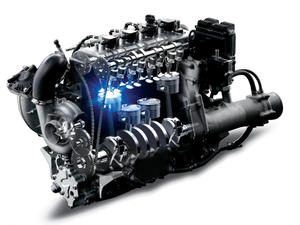 Yamaha’s 1.8-liter engine is the largest displacement mill in the PWC industry.
Yamaha’s 1.8-liter engine is the largest displacement mill in the PWC industry.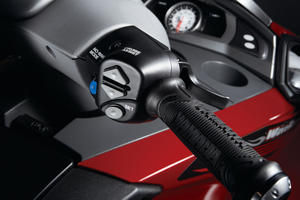 Controling speed is easy as pushing a button.
Controling speed is easy as pushing a button.Size matters, but a look at the engine’s actual horsepower may surprise you. Although Yamaha no longer publishes horsepower per company policy, a look at EPA statistics indicates the engine is around 202 hp, far less than the 260 horses in the new Kawasaki Ultra 260X. But while it may seem outmatched on paper, its real world performance is on par with the big guns. During my test I achieved a top speed of 67.4 mph, and a 0-30mph acceleration time a fraction over two seconds.
Equally important is what that engine makes possible. With the SHO, Yamaha adapted a drive-by-wire throttle, eliminating the physical cable that served as a link between the driver’s input at the throttle and the engine itself. This has allowed the craft to boast auto-like conveniences such as cruise control. Dubbed Cruise Assist by Yamaha, this rpm-based speed control can be set at any speed with the push of a handlebar-mounted button. The driver then simply fully squeezes the throttle to take fatigue and fluctuation out of the equation. Should the driver release, or even lessen pressure on the throttle, the system disengages. Once set, the speed can be bumped up or down in roughly 1 mph increments, within a range of about 10 mph.
Speed control is a great addition for cruising, but also a boon to wakeboard or ski enthusiasts, who now no longer have to contend with a driver with a less-than-steady throttle finger. On the flip side of the coin, the driver can also now just concentrate on the water and keeping a straight line, as struggling with a finicky throttle, particularly at wakeboarding speeds, is no longer an issue.
Yet another addition is a welcome No Wake Mode, again activated by a simple push-button control. Activate No Wake, and the craft settles in at about 5 mph, and does not require any pressure on the throttle. In practice I found this feature to make cruising lengthy no-wake zones far less of an aggravation, especially when trying to keep pace with other riders for conversation.
What’s In A Nano
Yamaha also turned to the technical wizards to come up with a new hull, deck, and liner material. The material itself is still Sheet Molding Compound (SMC), in layman’s terms a flexible fiberglass sheet, augmented with resin and filler, that is then placed into a high-pressure, high-heat mold to ultimately form a finished part. The difference with the new material, dubbed NanoXcel, is that Yamaha looked at the filler portion of the equation on a molecular level.
Here’s the Cliffs Notes version. Calcium carbonate served as the previous filler material, but hull gurus found that individual molecules stacked together like gumballs. The bonds formed between molecules were known as butt joints, a weaker solution that takes up more space and results in greater weight. Yamaha switched this material to clay, and found it could be exfoliated into very thin layers. Those layers could then be layered much like a brick wall is constructed, forming much stronger lap, or shear, joints thanks to the increased surface area. Less filler was required, and strength was improved. As Yamaha Product Manager Scott Watkins explained it to me, a fixed amount of SMC once required a handful of calcium carbonate. That same amount now requires only a pinch of clay.
The end result is a product that Yamaha touts as being both stronger and thinner than a traditional SMC creation, but also about 25-percent lighter in weight. In the case of the FX SHO, Yamaha reportedly dropped about 55 pounds off the finished product.
Let It Ride
Like most Yamahas, the FX SHO tracks excellent in rough water, with a stable and predictable nature that makes it a favorite for getting from Point A to Point B. There’s the occasional jolt as the boat smacks through rough water, but never a surprise. Cornering, however, can display the occasional quirk. Whether it’s the result of the craft being that much lighter, or simply the steering being very responsive, the SHO often seems to hook up hard, then briefly release in turns, giving the boat a slightly unsure nature at times. Overall, however, it’s still mostly the solid ride we’ve come to expect from Yamaha.
A manual, five-position trim can enhance top speed, or drop the bow for tighter cornering. It, too, has its strengths and weaknesses. On the positive side, its position on the left hand grip offers the ability to keep your eyes on the water, rather than check a display. The downside is that a great deal of thrust is exiting the nozzle at high speed, and it’s often hard to overcome its force on the nozzle. Electric trim solutions don’t have this limitation.
Reverse also draws mixed reviews. I love that rpm is limited to 3,000 rpm when backing up, preventing the cavitation that often results when a driver over-revs the impeller. Its location is still on the right hand side of the helm, however, a placement that forces those who prefer to combine reverse with throttle to do an awkward game of Twister to control the craft the way they desire. (Why the right? Yamaha will continue to say it’s the result of their legal department, who note the ability to pull on the reverse while applying throttle could suddenly submarine the bow and cause injury.)
Elsewhere, nice touches abound. A large bow tub can handle most of the gear your average rider will include. There’s also a small compartment under the split seat, a generous glove box, and a dry storage nook in front of the handlebars. Yamaha also includes a flip-down reboarding step for deep water boarding, a handy key fob security remote that can also activate a low-speed mode for beginners, and handlebars that can adjust in angle from 35-to-55 degrees with the pull of a lever.
One of the things I like best about the boat, however, is that it runs on plain old regular gasoline – no need for premium fuel. In fact, all Yamahas are designed to run on 87-octane.
Cruise Control
As has become customary for Yamaha, the FX SHO will be offered in two versions, the standard FX SHO and the more touring/comfort-oriented FX SHO Cruiser. The latter includes an ultra-plush, bolstered touring saddle that provides excellent back and hip support for both driver and passenger. The Cruiser also adds a fuel-flow meter to see how much fuel is currently being consumed, as well as handlebars that are positioned higher than the standard model.
The FX SHO starts at $12,599, and is offered in either a blue metallic or black; the FX Cruiser SHO at $13,199, in a choice of red or bronze metallic.
| Yamaha FX SHO/FX Cruiser SHO Specs | |
| Length | 132.7 inches |
| Beam | 48.4 inches |
| Dry Weight | 827/841 lbs |
| Engine | Four-cylinder DOHC EFI |
| Displacement | 1,812 cc |
| Bore and Stroke | 86mm x 78mm |
| Compression Ratio | 8.6:1 |
| Rated Horsepower | 202* |
| Fuel Capacity | 18.5 gal. |
| Combined Stowage Capacity | 26.4 gal. |
| Colors | Atomic Blue Metallic, Stealth Black (SHO), Crimson Red Metallic, Bronze Metallic (Cruiser) |
| Price | $12,599 (SHO) / $13,199 (Cruiser) |
Related Reading
2009 Yamaha WaveRunner FZR Review
2009 Yamaha WaveRunner Lineup
2008 Yamaha WaveRunner FX SHO Review
Get PersonalWatercraft.com in your Inbox!
Like PersonalWatercraft.com on Facebook
Comments
Most Popular

2025 Yamaha JetBlaster PRO 2-Up Review

2024 Kawasaki Jet Ski STX 160X Review

Remembering the Sea-Doo XP

Whatever Happened to the Wetbike?

2025 Yamaha JetBlaster Review




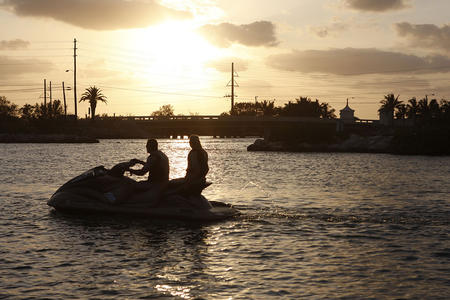
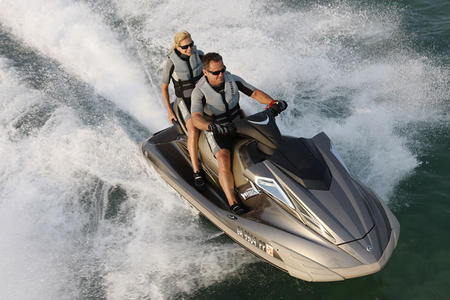
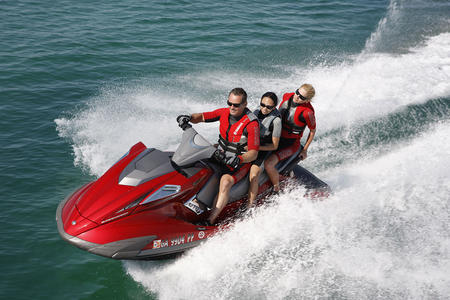
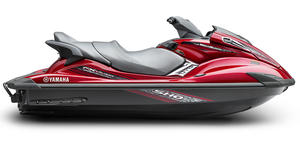

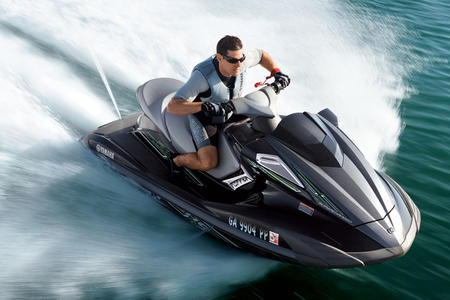







 Your Privacy Choices
Your Privacy Choices